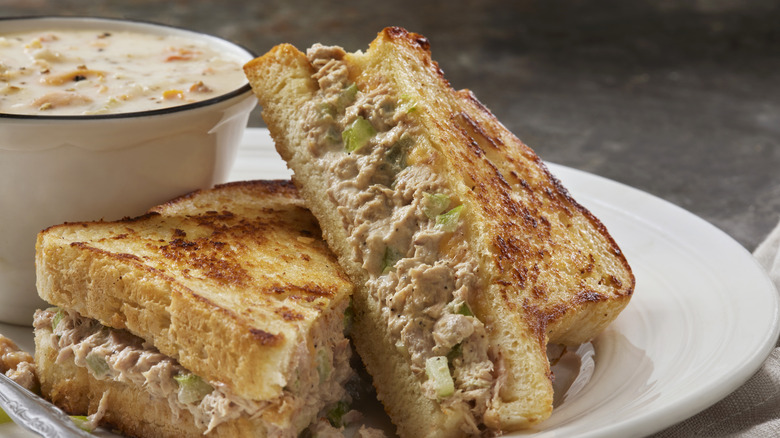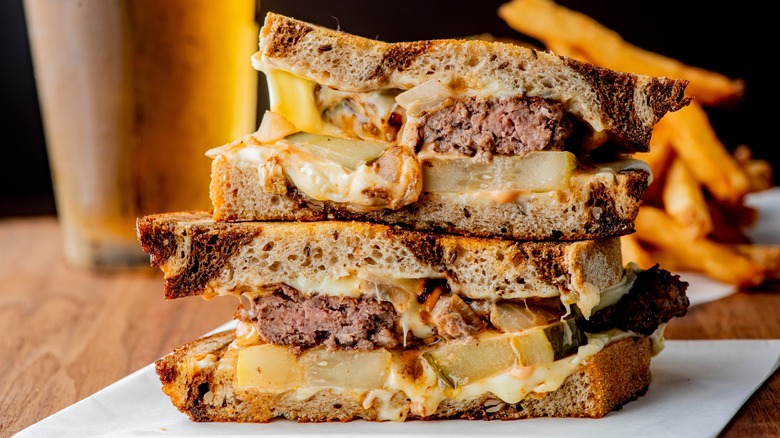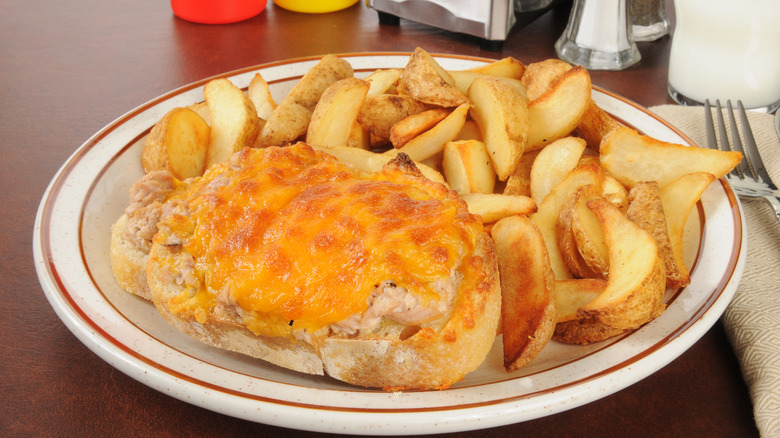The Mysterious Origins Of The Tuna Melt
Culinary history is one of the murkier endeavors when trying to reconstruct the past. Regional dishes get adapted into "new" formats, multiple creators take credit, tall tales proliferate. Spend enough time trying to find the actual origins of the cocktail or the hamburger, and your head will spin. While not nearly so well documented, the humble tuna melt also boasts mysterious beginnings, shrouded in under-documentation and modern folklore. It's likely we'll never know precisely how the comforting combination of bread, tuna salad, and grilled or broiled cheese came about, but it's been a staple of diners, delis, and kid lunches from the mid-20th century on.
There are certain historical truisms bookending the emergence of the tuna melt. Canned tuna made its debut around 1903, when a grocer in California swapped out cheap, widely available tuna in place of the much more popular sardine which was experiencing a shortage. Hotpoint introduced an electric kitchen range for the home in 1910, a big moment in home cooking, and broil rods were quickly introduced in several brands. While white bread loaves adorned bakery shelves for a long time, sliced bread first appeared by 1930, then got put on hold during WWII. And diner-style restaurants experienced renewed popularity and expansion in the 1940s and 50s, alongside a rise in preparing easy meals at home from pre-packaged food products (encouraged by the manufacturers themselves).
Evolution of the earliest tuna melts
So we know the tuna melt most likely appears on the scene between about 1920 and 1960, but that doesn't narrow it down much. Fortunately there is additional research. At the Food Timeline, the late Lynne Oliver found evidence supporting a post-war popularity of the sandwich. While cold tuna salad sandwiches, broiled sandwiches with cheese and other meats, and hot sardine sandwiches (no cheese) all show up in 1920s-era cookbooks, the first cookbook with a broiled, open-faced tuna fish sandwich with cheese appears in "The Joy of Cooking" in 1936, according to Oliver. Though a lot of broiled, toasted, and fried versions appear in the 1940s and '50s, none are called a "melt."
Oliver quotes food historian Jean Anderson as saying the first evidence for the actual term tuna melt is on family restaurant menus (like iHOP and Howard Johnsons) in the mid-1970s. Almost certainly the concept had infiltrated the zeitgeist before that: chain restaurants rarely innovate. In fact, the patty melt–consisting of ground beef, onions, and cheese–usually on toasted rye, made a definitive appearance in the 1950s on the menu of sister California drive-ins Biff's and Tiny Naylors. The concept spread quickly throughout the country, and could have been an inspiration for the tuna melt. The basic concept of hot fish salad and melted cheese was popular enough that by 1964, a cookbook in Ceylon included a recipe for "American Sardine Toast," essentially the same concept as a tuna melt.
The legend of the Woolworth's origin story
In 2015, Chewing the Fat quoted author Warren Bobrow, as claiming the tuna melt was born in 1965 at a Woolworth in South Carolina. He describes Chef Bo making grilled cheese sandwiches when "...a freshly made tuna salad sits on the edge [of the griddle]...and, as if guided by a hidden hand, the contents tip over, falling on the grilled cheese. Voila!" The unsubstantiated story (since promoted to "legend"), citing Bobrow, has been repeated by a number of websites, including The New York Times.
Bobrow's passion for the Charleston Woolworth tuna melt isn't in dispute. He was included in the 2010 issue of Saveur, highlighting 100 readers' favorite recipes. He extolls the virtues of the "freshly made tuna salad dotted with diced celery and Georgia sweet onions," the white bread "browned to a crisp on a flattop grill." When Chowhound reached out, Bobrow confirmed he lived in Charleston in the 1980s and was particularly fond of the Woolworth tuna melts, but is uncertain how he was credited with claiming the sandwich originated there. "That's a good question," he says. "But I don't believe it was invented there, only perfected." In all likelihood, whoever first quoted Bobrow probably misquoted him, or misunderstood what he was saying.
Whatever the case, tuna melts are delicious, and it's worth learning to make an unforgettable version by switching up the bread, or by adding anchovy paste to your mayo like Ina Garten.


